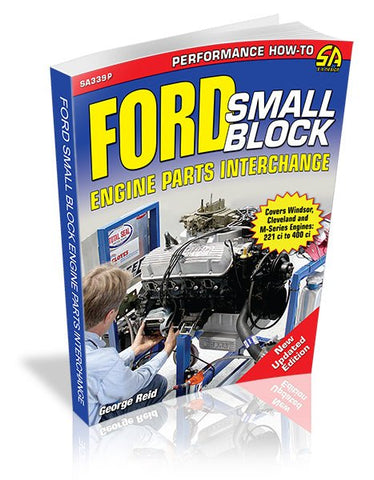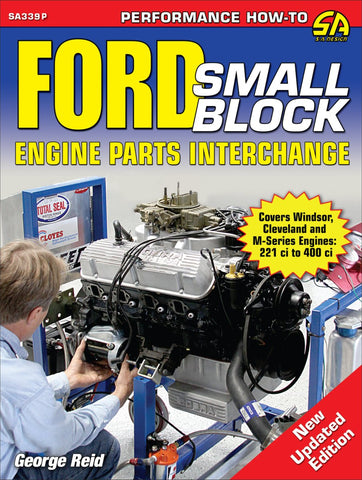If there is one thing Ford enthusiasts have learned over the years, it's that deciphering which Ford parts work with which Ford engines is a far more difficult task than with many other engine families. Will Cleveland heads fit on my Windsor block? Can I build a stroker engine with factory parts? Can I gain compression by using older-model cylinder heads, and will it restrict flow? Is there a difference between Windsor 2-barrel and 4-barrel heads? These are just a few examples of common questions Ford fans have. These and many other questions are examined in this all-new update of a perennial best seller.
Thoroughly researched and, unlike previous editions, now focused entirely on the small-block Windsor and Cleveland engine families, Ford Small Block Engine Parts Interchange includes critical information on Ford's greatest small-block engines and goes into great detail on the highly desirable high-performance hardware produced throughout the 1960s, 1970s, and 1980s. By combining some of the best parts from various years, some great performance potential can be unlocked in ways Ford never offered to the general public. Following the advice in Ford Small-Block Engine Parts Interchange, these engine combinations can become reality. You will find valuable information on cranks, blocks, heads, cams, intakes, rods, pistons, and even accessories to guide you through your project.
Author George Reid has once again done extensive research to accurately deliver a thorough and complete collection of Ford small-block information in this newly revised edition. Knowing what internal factory engine parts can be used across the wide range of production Ford power plants is invaluable to the hot rodder and swap meet/eBay shopper. Whether building a stroker Cleveland or a hopped-up Windsor, this book is an essential guide.
Acknowledgments
Introduction
Chapter 1:
General Data and Specifications
221
260
289
302
255
351W
Boss 302
351C
400/351M
Chapter 2:
Engine Block
Boss 302
351W
351C
351M/400
Cleveland Blocks
Ford Racing Blocks
Buying a Used Block
Chapter 3:
Rotating Assembly
221/260/289/302
Connecting Rods: 221/260/289/302
Boss 302
Flywheels and Flexplates: 221/260/289/302/Boss 302
Harmonic Balancers: 221/260/289/302/Boss 302
351W
Connecting Rods: 351W 51 351C/351M/400
Pistons: 221/260/289/302
Piston Rings
Chapter 4:
Lubrication
Pump Blueprinting
335-Series 351C/351M/400
Chapter 5:
Cylinder Heads
221/260
289
289 High Performance
302 68 255 69 351W
351C/351M/400
CHI Aftermarket Heads
Boss 302
“Aftermarket” Cylinder Heads
Valvecovers
Chapter 6:
Camshaft and Valvetrain
Cam Selection Considerations
Dual-Pattern Camshafts
Timing Set
Timing Cover
Valves, Springs, Retainers and Locks
Rocker Arms
Valvecovers
Chapter 7:
Induction
Carburetors
Manifolds
Fuel Pumps and Fuel Injection
Chapter 8:
Ignition, Charging and Starting
Autolite Distributors
Duraspark Ignition
Generators and Alternators
Starters
Senders
Chapter 9:
Exhaust
Single- and Dual-Exhaust Systems
Manifolds and Headers
Thermactor System
Chapter 10:
Cooling System and Front Dress
Radiator
Packaging Considerations
Water Pump
Fans and Spacers
Front Dress
If there is one thing Ford enthusiasts have learned over the years, it's that deciphering which Ford parts work with which Ford engines is a far more difficult task than with many other engine families. Will Cleveland heads fit on my Windsor block? Can I build a stroker engine with factory parts? Can I gain compression by using older-model cylinder heads, and will it restrict flow? Is there a difference between Windsor 2-barrel and 4-barrel heads? These are just a few examples of common questions Ford fans have. These and many other questions are examined in this all-new update of a perennial best seller.
Thoroughly researched and, unlike previous editions, now focused entirely on the small-block Windsor and Cleveland engine families, Ford Small Block Engine Parts Interchange includes critical information on Ford's greatest small-block engines and goes into great detail on the highly desirable high-performance hardware produced throughout the 1960s, 1970s, and 1980s. By combining some of the best parts from various years, some great performance potential can be unlocked in ways Ford never offered to the general public. Following the advice in Ford Small-Block Engine Parts Interchange, these engine combinations can become reality. You will find valuable information on cranks, blocks, heads, cams, intakes, rods, pistons, and even accessories to guide you through your project.
Author George Reid has once again done extensive research to accurately deliver a thorough and complete collection of Ford small-block information in this newly revised edition. Knowing what internal factory engine parts can be used across the wide range of production Ford power plants is invaluable to the hot rodder and swap meet/eBay shopper. Whether building a stroker Cleveland or a hopped-up Windsor, this book is an essential guide.
Acknowledgments
Introduction
Chapter 1:
General Data and Specifications
221
260
289
302
255
351W
Boss 302
351C
400/351M
Chapter 2:
Engine Block
Boss 302
351W
351C
351M/400
Cleveland Blocks
Ford Racing Blocks
Buying a Used Block
Chapter 3:
Rotating Assembly
221/260/289/302
Connecting Rods: 221/260/289/302
Boss 302
Flywheels and Flexplates: 221/260/289/302/Boss 302
Harmonic Balancers: 221/260/289/302/Boss 302
351W
Connecting Rods: 351W 51 351C/351M/400
Pistons: 221/260/289/302
Piston Rings
Chapter 4:
Lubrication
Pump Blueprinting
335-Series 351C/351M/400
Chapter 5:
Cylinder Heads
221/260
289
289 High Performance
302 68 255 69 351W
351C/351M/400
CHI Aftermarket Heads
Boss 302
“Aftermarket” Cylinder Heads
Valvecovers
Chapter 6:
Camshaft and Valvetrain
Cam Selection Considerations
Dual-Pattern Camshafts
Timing Set
Timing Cover
Valves, Springs, Retainers and Locks
Rocker Arms
Valvecovers
Chapter 7:
Induction
Carburetors
Manifolds
Fuel Pumps and Fuel Injection
Chapter 8:
Ignition, Charging and Starting
Autolite Distributors
Duraspark Ignition
Generators and Alternators
Starters
Senders
Chapter 9:
Exhaust
Single- and Dual-Exhaust Systems
Manifolds and Headers
Thermactor System
Chapter 10:
Cooling System and Front Dress
Radiator
Packaging Considerations
Water Pump
Fans and Spacers
Front Dress










